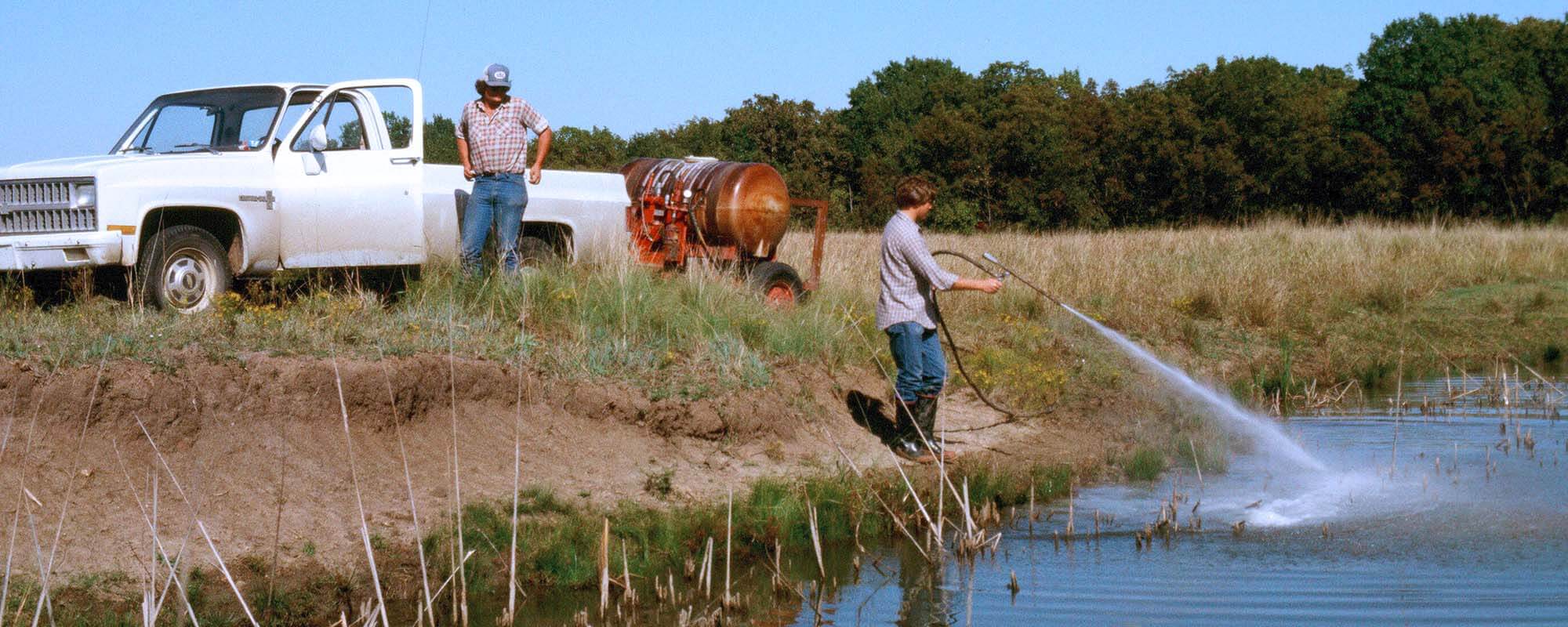Sometimes a pond manager wants to change a fishery in a pond by removing existing fish and restocking other fish. This commonly occurs when a pond with fish will be stocked with small fingerlings or when a pond is dominated by bullheads, common carp or stunted bream. Stocking small fingerlings into an existing fish population often gives poor results because existing fish out compete or eat small fingerlings. When overabundant, bullheads and common carp increase clay turbidity of a pond and reduce sport fish production. When bream are overabundant, they interfere with largemouth bass recruitment by eating too many bass eggs and fry, and their small size makes them inappropriate for human consumption and undesirable for angling. A pond manager basically has three options to remove existing fish: drain the pond, stock plenty of large predatory fish (adult largemouth bass primarily are used for this purpose) or treat the pond with a piscicide (chemical that kills fish). Rotenone is the piscicide most often used to kill fish.
Rotenone is a naturally occurring compound derived from the roots of certain tropical and subtropical legume plants. Humans have been using it for centuries to harvest fish and manipulate fish communities. Rotenone kills by inhibiting cellular respiration in mitochondria, which leads to reduced cellular uptake of oxygen. It affects most aquatic gill-breathing animals such as fish, amphibians and insects. At normal application rates, mammals, birds and reptiles are not affected because their skins inhibit absorption and enzymes in their digestive systems break down small amounts of rotenone into harmless products.
Rotenone is sold both as a powder and a liquid. The liquid form is more appropriate as a piscicide. Liquid rotenone is a restricted-use pesticide that can be purchased from certain pesticide suppliers. To legally use a restricted-use pesticide, a person must obtain pesticide applicator certification through the Cooperative Extension Service. In Oklahoma, permission from an Oklahoma Department of Wildlife Conservation game warden is also necessary before applying it to most private ponds. Permission from Texas Parks and Wildlife Department is not necessary for its use in Texas private ponds.
Liquid rotenone piscicide usually is available in a formulation with 5 percent active ingredient. When using the 5 percent formulation, it should be applied at rates of 0.1 to 5 parts per million (ppm) in ponds depending upon fish species, water pH, water alkalinity, water temperature, clay turbidity, aquatic vegetation, suspended organic material and purpose of the treatment. For example, a pond with common carp, bullheads, gars, basic pH, high alkalinity, cold or hot water, muddy water, abundant aquatic plants, abundant suspended organic material and a total fish kill objective requires more rotenone than a pond with shads, breams, crappies, basses, neutral pH, low alkalinity, cool water, clear water, no plants, little organic material and a partial fish kill objective. One gallon of 5 percent rotenone applied to 3 acre-feet of water volume gives 1 ppm concentration of bulk piscicide. A pond’s water volume should be accurately measured to facilitate proper application of rotenone.
Immediately prior to application, rotenone should be diluted with about 10-15 times as much water. The rotenone-water mixture can be mixed and temporarily stored in a washtub, sprayer tank or barrel. People should avoid skin, mouth or eye contact with concentrated rotenone or the 1:10-15 mixture. The mixture should be applied uniformly across a pond on the same day that it is mixed.
I prefer to first pump or siphon some of the mixture down into the portion of the pond that is deeper than 6 feet. Then, I apply the mixture to the main body of the pond with a siphon, sprayer, cup or small bucket. Finally, I treat the shallow edges of the pond. I also prefer to mix the pond with an outboard motor immediately after rotenone application, but I try to minimize stirring up mud.
A treated pond should be observed at dawn of the morning following a rotenone application to look for fish activity at the surface. If any fish are still alive, most should be near the surface at dawn when dissolved oxygen is normally the lowest. Fish often try to pipe (gulp a mixture of air and water from the surface) when stressed with rotenone. If any fish are still alive, the pond should be treated again with rotenone as soon as possible.


Comments